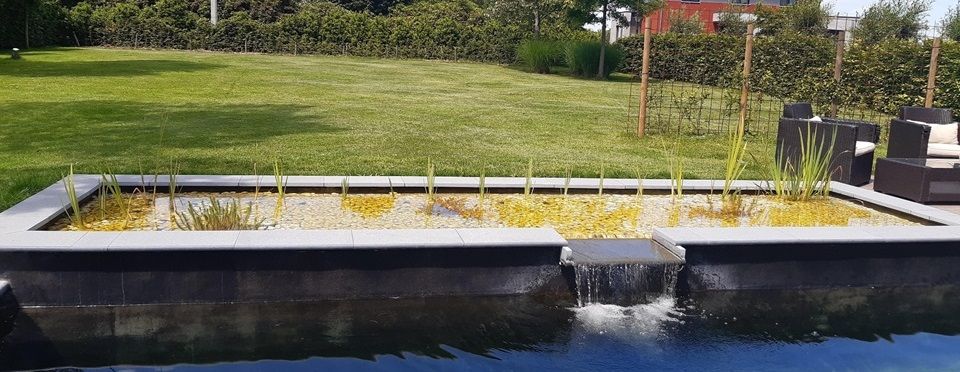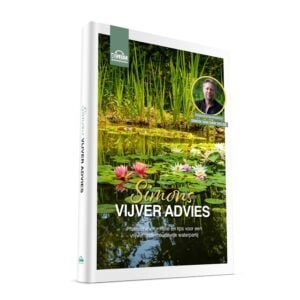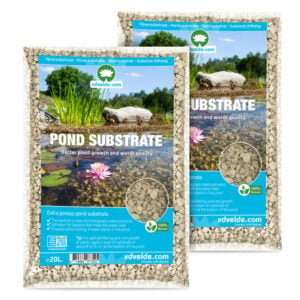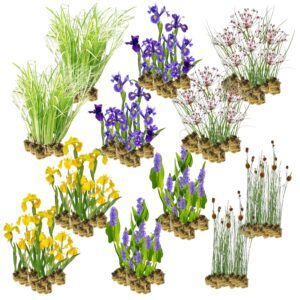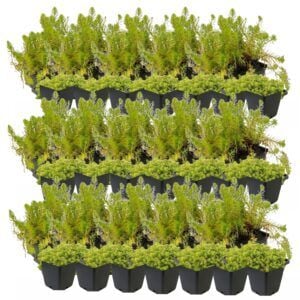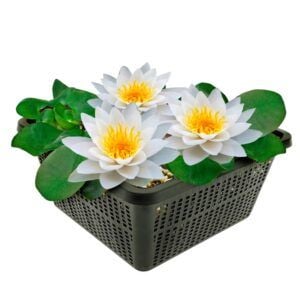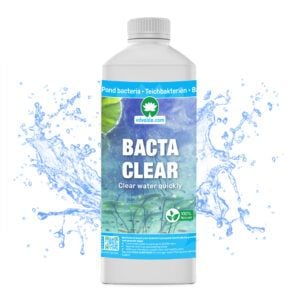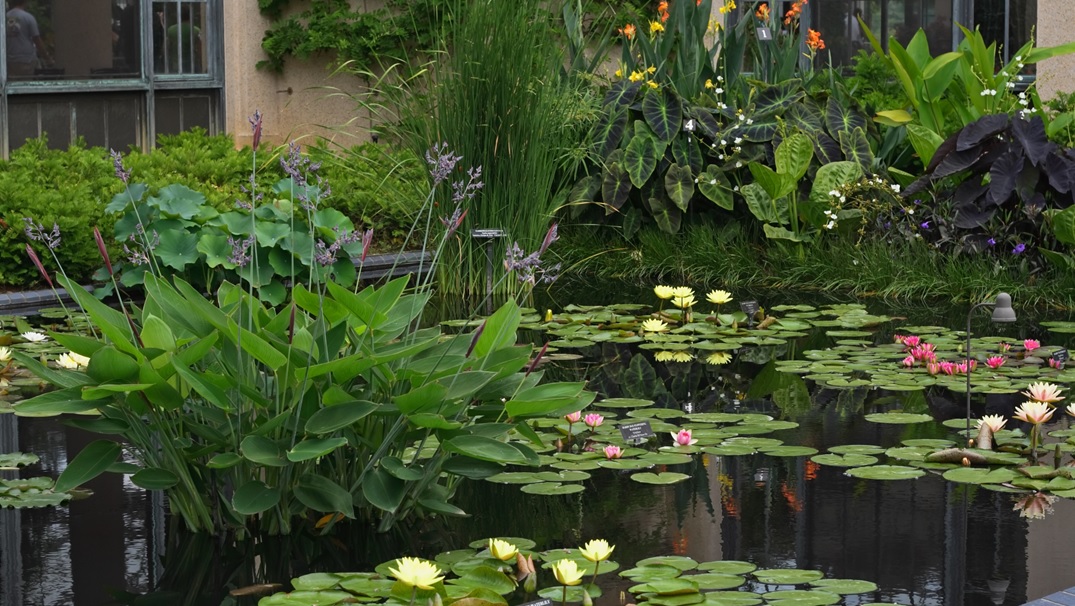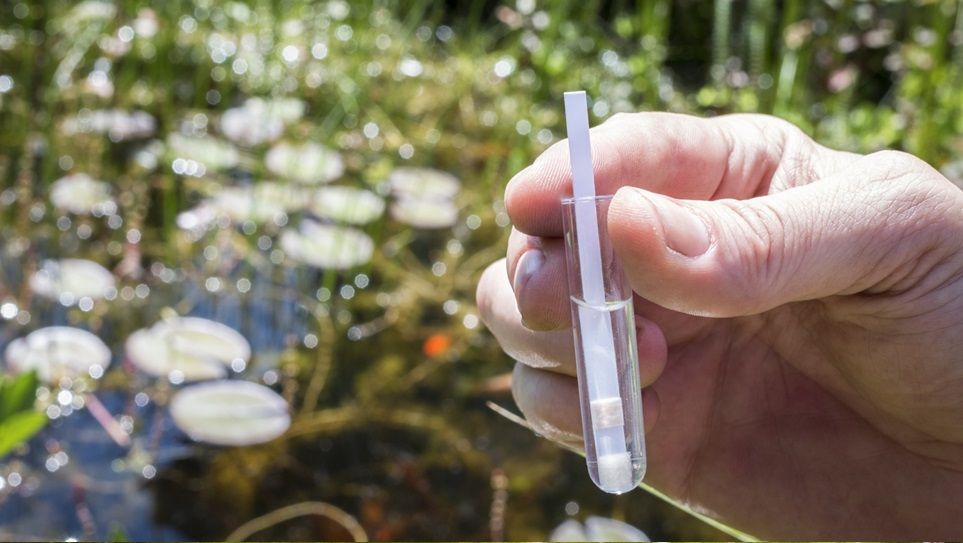Plant filter
Plant filter
Want to create a plant filter in your pond that replaces a pond pump, pond filter and unnecessary chemicals?
Then follow our expert 6-step plan and build your own plant or helophyte filter.
Save at least €1000 euros and avoid common mistakes with the "Simons Pond Advice Book.
Order all the aquatic plants you need for your plant filter easily and quickly through our online shop.

A plant filter is perfect if you want to keep your pond clear naturally. It replaces mechanical filters and pumps so you contribute to strengthening the world's biodiversity.
Others bought this for their plant filter
Simons Pond Advice Book
- Choose your language of the book
- Complete pond handbook
- 100+ pages from construction to maintenance
POND SUBSTRATE Pond substrate - 40 liters
- 40 L covers 1 m² ↥ 10 cm
- Heavy duty quality for the best filtration
- Extra porous: optimal plant growth
Thread Algae Fighting Plant Filter Package - L
- For 8 - 12 m²
- 96 plants
- Placement: -1 to -20 cm
White Water Lily - Nymphaea Albatross
- Large water lily
- Full-grown height: 10 cm
- Placement: -10 to -100 cm
BACTA CLEAR
- For 1,000 to 20,000 L
- 100% eco: clear water fast
- Safe for humans, plants & animals

Plant filters replace pumps and filters
There are different types of plant filters, such as helophyte filters, swamp filters, swimming pond filters and plant filter trays.
All of these filters have one common function: to naturally purify your pond. They use substrate, pond bacteria, oxygenating plants and purifying aquatic plants to accomplish this.
Save money by getting rid of unnecessary products to keep your pond balanced. Follow our step-by-step plan for an optimally functioning plant filter, which not only saves costs, but also reduces maintenance. Let nature do the heavy lifting and enjoy your beautiful pond more!
A helophyte filter is a type of plant filter that uses specific water purifying plants called helophytes. These plants are great for extracting nutrients from the water, helping to purify your pond. This natural process replaces the need for mechanical pumps and filters. Such a filter not only creates a healthy ecosystem for your pond but also contributes to the biodiversity of your garden.
By making creative use of these natural filters, you can maintain a pond that is both aesthetically pleasing and ecologically sound. Our step-by-step plan helps you make the right choices when setting up your plant or helophyte filter. That way, you'll create a balanced and self-sustaining pond island that you can enjoy to the max with minimal effort.
filter pumps / UV lamps vs Plant filter

|

|
|
|---|---|---|
Filter pump and UV lamps |
Plant filter |
|
| ❌ Regular & time-intensive | ✅ Minimal & simple | |
| ❌ Often needed | ✅ Chemistry-free, natural filtration | |
| ❌ Higher current expenses | ✅ One-time investment, lower maintenance costs | |
| ❌ Technical | ✅ Natural & aesthetic | |
| ❌ May be harmful to some organisms | ✅ Promotes biodiversity | |
| ❌ Higher energy consumption | ✅ Energy efficient |

Build your own plant filter in 5 steps
1. What kind of plant filter?
Before you get started installing a plant filter, it is essential to research which type will best suit the type of pond you have in mind.
Swimming pond: For a swimming pond, it is best to choose a helophyte filter or swimming pond filter.
Koi pond: For a koi pond, it is advisable to choose a screened swamp filter or a plant filter tank. This will prevent the fish from accessing the plants.
Mirror Pond: For a mirror pond, we recommend a swamp filter. With a swamp filter, the pond maintains a sleek appearance.
2. Determine dimensions
After choosing your plant filter, it is important to think about its size in relation to your pond. We recommend setting up about ⅓ to ⅔ of the pond surface as a plant filter. An ideal depth for the plant filter is about 40 cm. Then fill most of this with a layer of pond substrate of about 30 cm. In a plant filter, you use a thicker layer of substrate than in the rest of the pond. This is necessary because the plant filter has a smaller surface area, but still needs to filter efficiently. In this way, you ensure that your plant filter contributes effectively to the purification of your pond.
3. Substrate
For an effective plant filter, pond substrate is an excellent choice because of its porous structure, which leads to better filtering performance. First, calculate how much substrate you need for your plant filter. Make sure it contains about 30 cm of substrate, with a 10 cm layer of water above it. In the rest of the pond, depending on the type of pond, apply an 8-10 cm layer of substrate to the bottom. In a swimming pond, you leave out this layer of substrate because it is not comfortable during swimming. In this way you ensure a well-functioning plant filter and a pleasant swimming pond.
4. Furnish plant filter with pond filter plants
Oxygen plants:
- Strong oxygen plants are: Ground Featherweed, Needleweed or Lid Stem.
- Minimum of 2 baskets of 8 oxygen plants per 1,000 gallons of water.
Purifying aquatic plants:
- Best purifying aquatic plants are: Pied Calamus, Sumpf schwertlilie, Pikeweed, Swan Flower.
- Minimum of 2 baskets of 8 aquatic plants per 1,000 gallons of water.
5. Pond bacteria
1 bottle of Bacta Clear from 1 to 20 m³ (1,000 to 20,000 liters of water).

Plant filter planting plan
We give you of information on how to set up and plant a plant filter in a completely natural way so that the use of filters and pumps becomes unnecessary.
1. Pond substrate: for a good start
Simons advice for pond substrate
Use 120 liters of substrate (6 bags) per m3, so that you have a layer of about 30 cm of substrate in the plant filter.
POND SUBSTRATE Pond substrate - 40 liters
- 40 L covers 1 m² ↥ 10 cm
- Heavy duty quality for the best filtration
- Extra porous: optimal plant growth
2. Plant filter as a natural filter
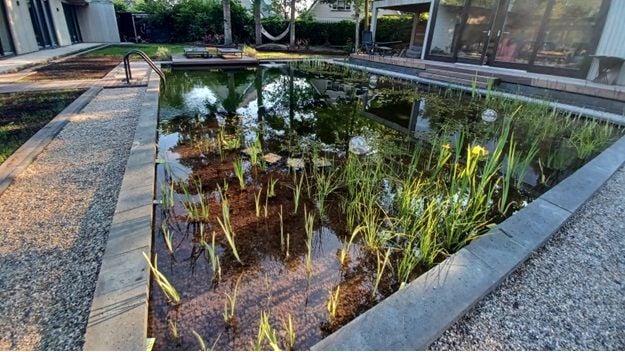
A plant filter is a valuable addition to your swimming pond, mirror pond or garden pond. Although it is not always pleasant to have aquatic plants in the swimming area, they are essential for a healthy pond. With a plant filter, you can screen aquatic plants from the swimming area, allowing them to perform their functions without disrupting your swimming enjoyment. It is very important to place enough aquatic plants in the plant filter to keep the water clear and healthy,
Simons advice for filter plants
Use a minimum of 16 filter plants per 1,000 gallons of water.
3. Oxygen plants: keep water clear and healthy
Want to prevent an algae explosion of floating or filamentous algae? Then make sure to place plenty of oxygen plants in your pond early in the season, around March or April. The top layer of water warms up quickly once the first rays of sunlight appear, causing algae to start growing. Existing ponds also need additional oxygen plants. The lower water layer, where oxygen plants overwinter, warms up later than the upper layer. This causes oxygen plants to grow slower than algae, which is a common problem in natural pools.
No one wants algae in their pond, and certainly not in a swimming pond. Most problems in plant filters and swimming ponds are caused by a lack of plants. Therefore, always invest in additional low-growing oxygen plants such as Needleweed and Acreweed. These plants cover the water surface and prevent the sun from quickly warming the water. Moreover, they convert carbon dioxide in the water into oxygen, which contributes to the death of algae.
Simons advice for filter plants
Always make use of Acreweed and Needleweed as perennial oxygen plants. Place 4 to 8 plants per 1 m², depending on how quickly you want to see results.
Thread Algae Fighting Plant Filter Package - L
- For 8 - 12 m²
- 96 plants
- Placement: -1 to -20 cm
4. Water lilies: prevent algae with a water lily
Simon's advice for water lilies
A water lily thrives in as little as 10 inches of water and can then produce flowers. There is room for a water lily in almost any plant filter, with a minimum of 1 water lily per 0.5 to 3 sq. m.
White Water Lily - Nymphaea Albatross
- Large water lily
- Full-grown height: 10 cm
- Placement: -10 to -100 cm
5. Pond bacteria
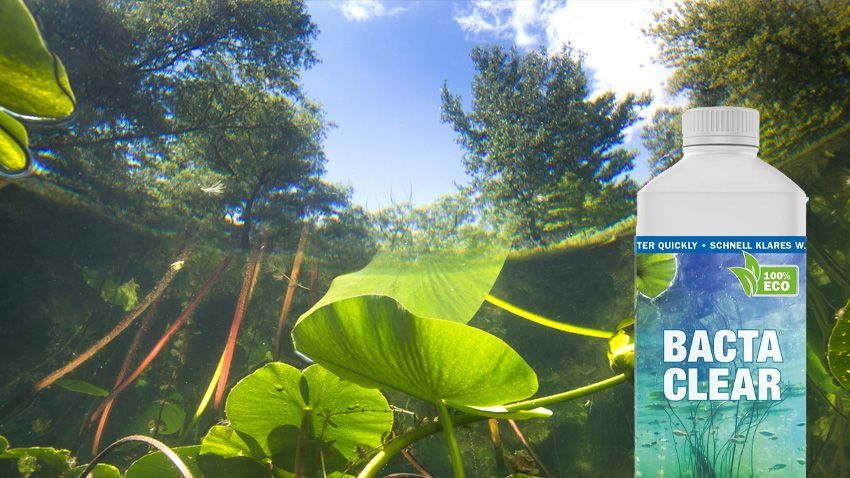
Finally, it is important to add a bottle of Bacta Clear to your pond water twice a year: once in the spring and once in the fall. This ensures that your pond remains clear and balanced. Bacta Clear contains a mix of two types of bacteria that remove waste products from the water. This increases oxygen levels in the water, which in turn promotes the growth of pond plants. One bottle of Bacta Clear is suitable for ponds up to 20,000 liters and is not harmful to humans, plants or animals.
Simons advice for pond bacteria
1 bottle of Bacta Clear from 1 to 20 m³ (1,000 to 20,000 liters of water).
BACTA CLEAR
- For 1,000 to 20,000 L
- 100% eco: clear water fast
- Safe for humans, plants & animals

Simon van der Velde: Expert on ponds and an advocate of biodiversity and sustainability
Simon van der Velde is an expert in ponds with more than 35 years of experience in designing dream ponds. He is the founder of "Van der Velde Aquatic Plants," a company focused on creating biodiverse and natural ponds without the use of pumping systems and filters. Simon's vision goes beyond creating beautiful ponds; he also wants to contribute to the restoration of biodiversity in the Netherlands, Europe and the rest of the world. In addition to his work as a pond specialist, Simon is a passionate nature lover and is committed to preserving nature and the environment. He inspires people to take a sustainable approach to their gardens and the natural environment. Simon's passion for biodiversity and natural lifestyle makes him an advocate for sustainability and a key player in restoring the natural balance in our world.

- Unfortunately, a common mistake: the pond is already filled with water while the pond plants have yet to be placed. This makes it difficult or even impossible to place all the plants in a good, sturdy spot. Simon therefore recommends starting first with a thin layer of pond substrate in an empty pond, after which you only allow a small layer of water into the pond. You can now step through the pond with boots on to place the aquatic plants in place in the substrate. Then top up with substrate. Is everything set and firm? Only then fill the entire pond with water.
- If you have a somewhat larger pond, it is smart to work from the inside out. So you start in the lowest zone and work outward step-by-step. You end in the shallowest zone (swamp zone).
- When placing the aquatic plants, also pay attention to what depth is best for optimal growth. This is indicated on the packaging of our pond plants. Do you like a lot of plants? Then place the baskets or crates against each other.
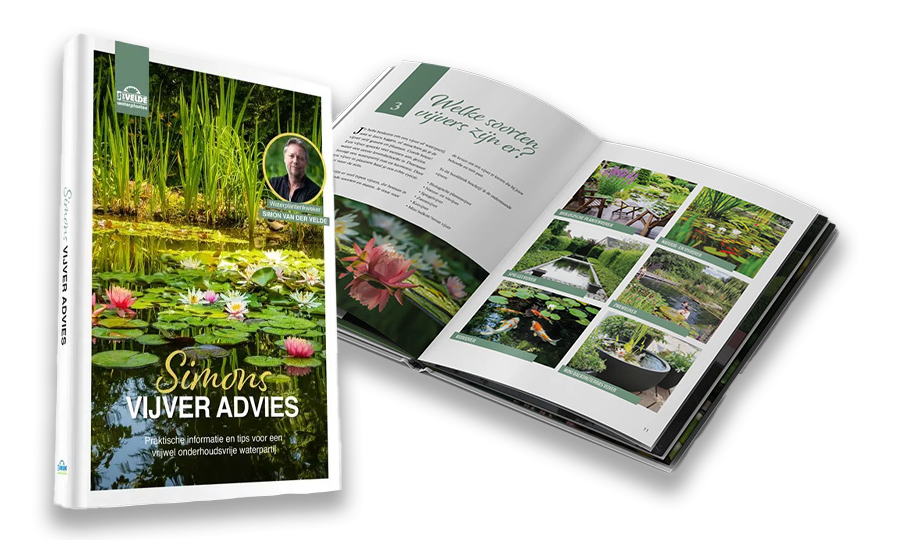
Want more helpful tips?
This is what our customers say!
Excellent 300+ reviews at
Great advice and material from Simon for our new pond.
So without any prior knowledge from us now for 3 years a picture in the garden and beautiful clear water 🍀🙏
Great products and knowledgeable!
Ordered 6 x crab crab, these arrived somewhat short-winged and did not float well in the pond. But with some patience and attention they have now grown beautifully large and are flowering beautifully!
For 30 years I have had a pond. Remodeled this season with some of my old pond water and plants.
Supplemented with clear pond suggestions from van der Velde. The result is better than I ever had: beautiful plants and so clear that I can see the fish down to the bottom.
Really great !!!
A first patio pond is fun and exciting to experiment with. With the help of the excellent, involved support, the plants from the mini kit have come to life. Thanks to the addition of extra bacteria, I can now easily see a frog swimming in the mini pond. Thanks to Britt for her good advice. Also, the delivery is careful and fast. So far, a beautiful water lily has appeared twice, folding its leaves to go to sleep at night.Just following this cycle is beautiful.
Without too much experience, I began a sizable pond project. I bought Simon's book, and it helped me tremendously, both in construction and setup. Then I ordered the substrate, bacteria and all the plants, following as much as possible the method described in the book, for a natural pond without pumps and filters.
Very knowledgeable advice, extensive web shop and above all, excellent customer service.
My supplied Cape Lily turned out not to be viable, without any problems a new one was then sent in no time.
Can't say that I super liked what I ordered from Van der Velde. Plants, food, ground cover, gravel.
Well packed, fast delivery, and excellent quality!
If you have not ordered anything I would do it quickly, you will not regret it.
Good luck !

Simon van der Velde: Expert on ponds and an advocate of biodiversity and sustainability
Simon van der Velde is an expert in ponds with more than 35 years of experience in designing dream ponds. He is the founder of "Van der Velde Aquatic Plants," a company focused on creating biodiverse and natural ponds without the use of pumping systems and filters. Simon's vision goes beyond creating beautiful ponds; he also wants to contribute to the restoration of biodiversity in the Netherlands, Europe and the rest of the world. In addition to his work as a pond specialist, Simon is a passionate nature lover and is committed to preserving nature and the environment. He inspires people to take a sustainable approach to their gardens and the natural environment. Simon's passion for biodiversity and natural lifestyle makes him an advocate for sustainability and a key player in restoring the natural balance in our world.
Pond advice and tips
Frequently asked questions about plant filters
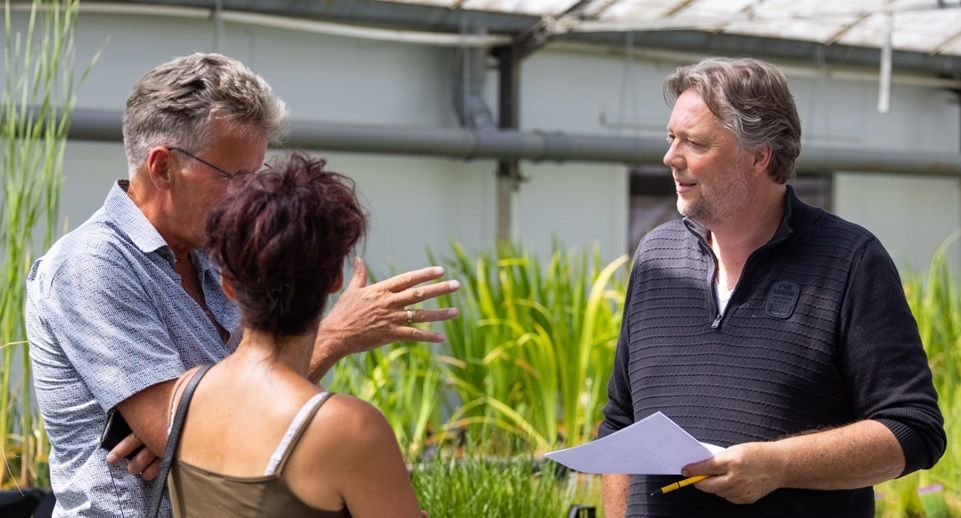
A plant filter is a general term for a water treatment method that uses aquatic plants to purify water. A swamp filter and a helophyte filter are specific types of plant filters. A marsh filter uses Sumpfpflanzen to purify water, while a helophyte filter specifically uses helophytes (reed-like plants).
A plant filter purifies water through plant roots and microorganisms that live in the root zone. These organisms break down harmful substances, such as ammonia and nitrites, and absorb nutrients, making the water clearer and cleaner.
Several types of aquatic plants can be used in a plant filter, including oxygen plants such as hornwort and waterweed, as well as Sumpfpflanzen such as iris and calamus. The choice of plants depends on the specific needs of the pond.
In many cases, a well-designed plant filter can reduce or even eliminate the need for mechanical filters. However, it depends on the size and type of pond, as well as the fish population. Some ponds may benefit from a combination of plant filters and mechanical filters.



